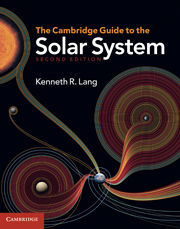Book contents
- Frontmatter
- Contents
- List of focus elements
- List of tables
- Preface to the second edition
- Preface to the first edition
- Principal units
- Part 1 Changing views and fundamental concepts
- Part 2 The inner solar system: rocky worlds
- Part 3 The giant planets, their satellites and their rings: worlds of liquid, ice and gas
- Part 4 Remnants of creation: small worlds in the solar system
- Part 5 Origin of the solar system and extrasolar planets
- Author index
- Subject index
Preface to the second edition
Published online by Cambridge University Press: 05 August 2011
- Frontmatter
- Contents
- List of focus elements
- List of tables
- Preface to the second edition
- Preface to the first edition
- Principal units
- Part 1 Changing views and fundamental concepts
- Part 2 The inner solar system: rocky worlds
- Part 3 The giant planets, their satellites and their rings: worlds of liquid, ice and gas
- Part 4 Remnants of creation: small worlds in the solar system
- Part 5 Origin of the solar system and extrasolar planets
- Author index
- Subject index
Summary
The second edition of The Cambridge Guide to the Solar System brings this comprehensive description of the planets and moons up to date, by extending it to include fascinating new discoveries made during the previous decade. As with the first edition, it is written at an introductory level appropriate for high-school and undergraduate students, while also providing fresh, current insights that will appeal to professionals as well as general readers with an interest in planetary science. This is accomplished in a light and uniform style, including everyday metaphors and many spacecraft images.
This second edition is filled with vital new facts and information, and lavishly illustrated in color throughout. Hundreds of new images have been provided. Most of these illustrations have never appeared together in print before, and many of them have a beauty comparable to works of art.
An Internet site for use by the instructor, students or casual reader also supports this book. It contains all of the images in this second edition, together with their legends and overview bullets of their seminal content. This site also includes similar material for the author's books about the Sun, including the second edition of Sun, Earth and Sky and the second edition of The Sun from Space. The website address is http://ase.tufts.edu/cosmos/.
Striking examples of new images from contemporary planetary spacecraft include the Chandrayaan-1 and LCROSS missions to the Moon, the MESSENGER spacecraft that is viewing the unseen half of Mercury, the 2001 Mars Odyssey, Spirit and Opportunity Exploration Rovers and Phoenix lander on Mars, the Cassini–Huygens mission to Saturn and its moons Enceladus and Titan, the Deep Impact and Stardust encounters with comets, with Stardust's sample return to Earth, and the Hayabusa encounter with the asteroid Itokawa.
- Type
- Chapter
- Information
- The Cambridge Guide to the Solar System , pp. xv - xviPublisher: Cambridge University PressPrint publication year: 2011



